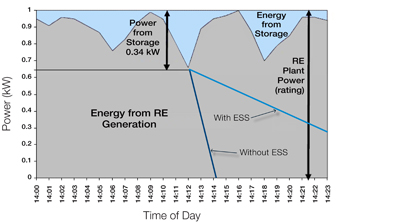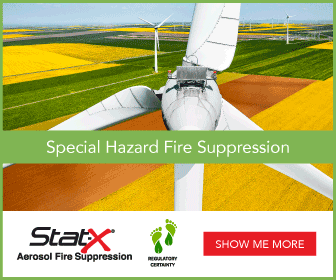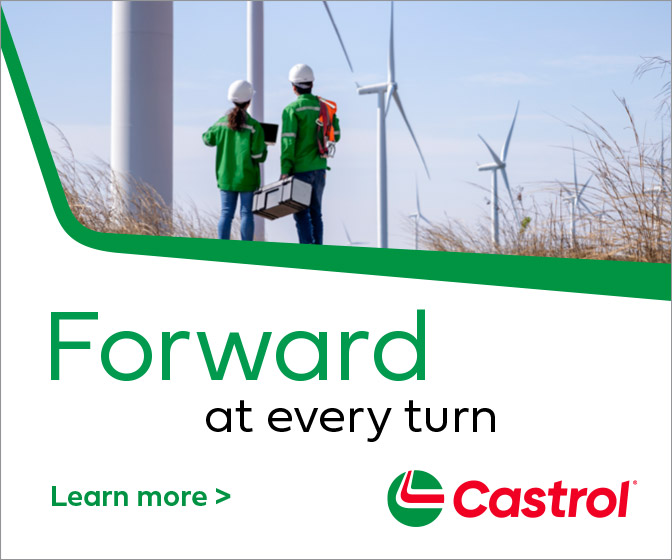Battery Energy Storage: Benefitting wind integration & power performance
 As the drive to meet wind energy potential continues to accelerate in North America and worldwide, the ability of wind facilities to provide consistent, high-quality power to the grid becomes increasingly important for the reliable operation of large-scale installations. Though advancements in turbine technology have enabled wind facilities to comply with stringent grid code requirements, the intermittent nature of wind continues to be a key challenge for achieving bulk wind penetration.
As the drive to meet wind energy potential continues to accelerate in North America and worldwide, the ability of wind facilities to provide consistent, high-quality power to the grid becomes increasingly important for the reliable operation of large-scale installations. Though advancements in turbine technology have enabled wind facilities to comply with stringent grid code requirements, the intermittent nature of wind continues to be a key challenge for achieving bulk wind penetration.
Through high-tech features and configurable options, battery energy storage systems can enhance the performance of wind facilities by providing grid code compliance and ancillary service capabilities. Specifically, these battery energy storage systems provide performance characteristics not traditionally seen in wind facilities, including but not limited to power smoothing (capacity firming), grid stability, and regulation. The inherent reactive power and voltage control capabilities of the system also provide the wind facility with an additional mechanism for providing regulation, diversifying grid investments, and enhancing reliability.
Key drivers & challenges
The drivers to achieve higher levels of sustainable, clean electrical energy are well known. Load growth forecasts, coupled with energy prices, supply uncertainties, and environmental concerns, are forcing nations around the world to rethink their energy mix and develop diverse sources of renewable energy.
To facilitate this drive, policy mechanisms such as tax incentives, feed-in-tariffs, and renewable portfolio standards (RPS) have been implemented to accelerate investments in renewable energy technologies. To date, 33 states within the United States have identified targets of up to 20% renewable penetration in the next 10 to 20 years to further promote growth, plus a strong case for a national RPS continues to be made in the US Congress. There are costs and challenges associated with a 20% wind scenario, but the target is considered achievable, given the current flexibility in the US grid infrastructure.
Key to achieving these targets is the robustness of the electrical grid itself. As the amount of wind generation continues to represent a larger percentage of overall energy mix, the existing flexibility of the grid is inherently stressed, forcing utilities and grid operators to consider critical upgrades and operational considerations, such as curtailment to maintain reliable power.
Energy policies typically require the use of wind energy when available. Coupled with higher penetration levels, scenarios could exist where levels of fast responding generators, such as gas-fired plants, are exceeded. This results in the operation/reduction of slower responding generation, such as coal-fired plants adversely affecting system efficiency and maintenance intervals per the following:
• Thermal plants operating at lower capacity factors;
• Thermal plants ramping more frequently;
• Thermal plants operating more sporadically; as well as
• Lower efficiency, higher fuel consumption, and higher emissions.
In addition, there continues to be recognition that remotely located wind facilities, coupled with variability, create a need to carefully consider voltage control, regulation, and system stability. Grid operators are, therefore, forced to tighten grid connection rules, or grid codes, to limit the effects of wind power parks on the network quality and stability.
Battery storage solutions
Given the various challenges to bulk renewable integration, battery energy storage systems (BESS) have emerged as a viable solution for allowing renewable generators to perform more similar to conventional generators. As wind turbine technology continues to improve, in many instances employing advanced control and power electronic systems, the value of storage as a fast responding, customizable solution for renewable energies can be derived from the following enhancements:
Capacity firming, smoothing & ramp rate control
• Compensates for short-term intermittency from wind and solar;
• Keeps renewable production within acceptable forecasted window; and
• Reduces amount of fossil fuel generation needed to compensate for variable generation.
Grid stability
• Maintains power until alternative power is brought online/dispatchable loads are disconnected; and
• Avoids power system collapse when renewables are quickly dispatched from network.
Regulation & grid code compliance
• Power factor and voltage regulation;
• Power quality; and
• Ancillary services.
These enhancements allow wind facilities to overcome grid constraints, diversify grid investments, offer ancillary services, as well as stabilize frequency.
Connecting storage to the grid
Smart Grid connected power converters combine bi-directional, four-quadrant power electronic devices, such as Insulated Gate Bipolar Transistors (IGBT) or Integrated Gate Commutated Thyristors (IGCT), with an advanced control and monitoring platform. When combined with an energy source, such as batteries, flywheels, or ultra capacitors, power converters can dynamically control active and reactive power to facilitate a number of grid functions, including, but not limited to:
• Voltage control
• Frequency regulation
• Capacity firming
• Ramp rate control
• Dynamic power control
• Generator emulation
• Islanding
Specifically, the PCS dynamic power control capability is customizable to the grid application, including to: voltage and frequency control set-points; prioritization of Q over P for voltage ride-through (VRT) grid support; and market-based control signals. The PCS advanced control and monitoring systems allow for communication and integration into local Energy Management Systems (EMS), site control systems, and Network level SCADA systems, further permitting a wind or solar facility to mimic the capabilities of conventional generators.
Conclusion
Renewable energy penetration is only going to increase in the upcoming years. Without a means to overcome the inevitable challenges, customers won’t fully appreciate the green and invaluable benefits, and utilities won’t see the optimized return on their investment. Fortunately, battery energy storage systems, along with smart grid converters, will play a major role in the emerging smart grid modernization movement of the 21st century, and these energy storage systems are already providing a feasible, proven, and commercially available solution.
Joe Fox is a sales application engineer for ABB in Wisconsin, and Alexandra Goodson is the business development manager for Energy Storage Modules in Florida.
ABB, Inc.
www.abb.us
Author: Joe Fox & Alexandra Goodson
Volume: September/October 2012









.jpg?r=6909)


